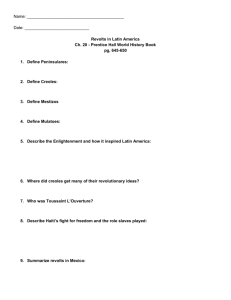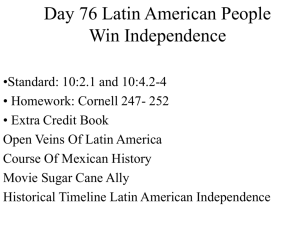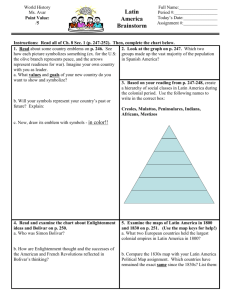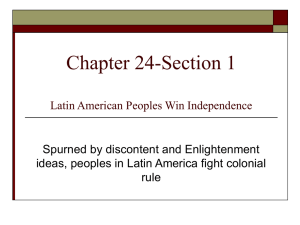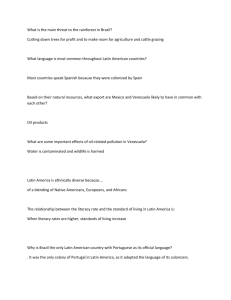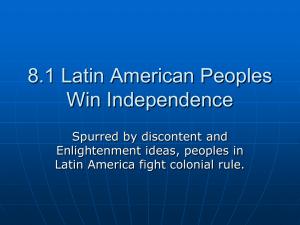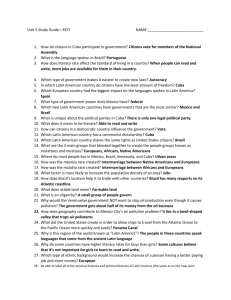Chapter 8 Section 3 Group Notes
advertisement
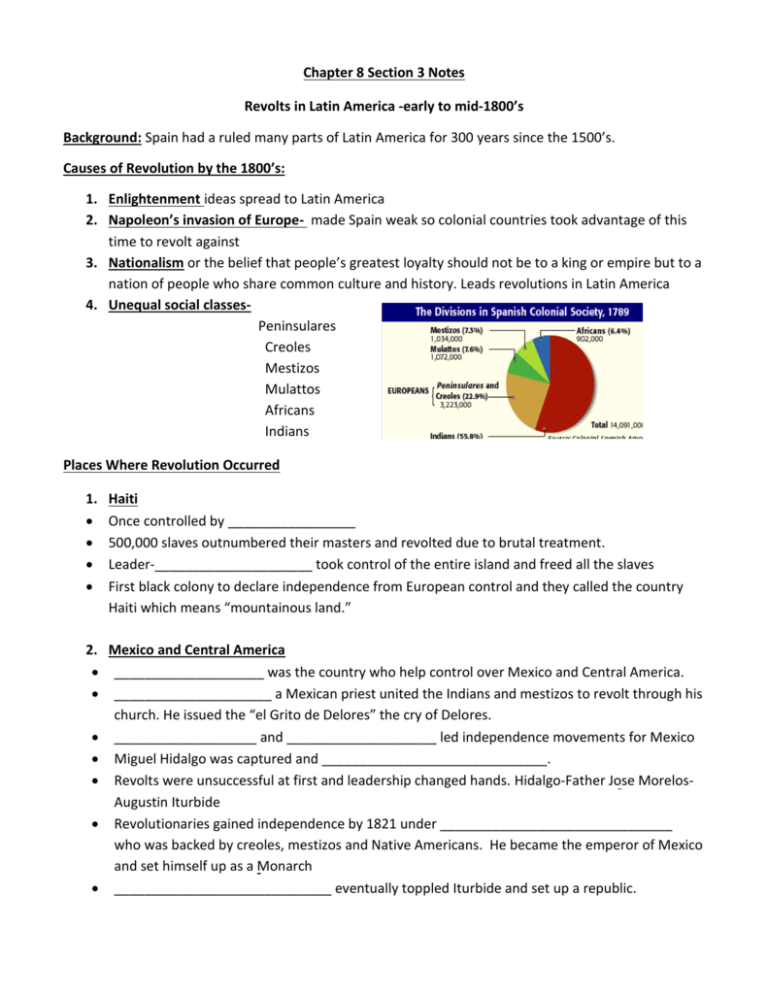
Chapter 8 Section 3 Notes Revolts in Latin America -early to mid-1800’s Background: Spain had a ruled many parts of Latin America for 300 years since the 1500’s. Causes of Revolution by the 1800’s: 1. Enlightenment ideas spread to Latin America 2. Napoleon’s invasion of Europe- made Spain weak so colonial countries took advantage of this time to revolt against 3. Nationalism or the belief that people’s greatest loyalty should not be to a king or empire but to a nation of people who share common culture and history. Leads revolutions in Latin America 4. Unequal social classesPeninsulares Creoles Mestizos Mulattos Africans Indians Places Where Revolution Occurred 1. Haiti Once controlled by _________________ 500,000 slaves outnumbered their masters and revolted due to brutal treatment. Leader-_____________________ took control of the entire island and freed all the slaves First black colony to declare independence from European control and they called the country Haiti which means “mountainous land.” 2. Mexico and Central America ____________________ was the country who help control over Mexico and Central America. _____________________ a Mexican priest united the Indians and mestizos to revolt through his church. He issued the “el Grito de Delores” the cry of Delores. ___________________ and ____________________ led independence movements for Mexico Miguel Hidalgo was captured and ______________________________. Revolts were unsuccessful at first and leadership changed hands. Hidalgo-Father Jose MorelosAugustin Iturbide Revolutionaries gained independence by 1821 under _______________________________ who was backed by creoles, mestizos and Native Americans. He became the emperor of Mexico and set himself up as a Monarch _____________________________ eventually toppled Iturbide and set up a republic. _________________________________________________________ (present day-Nicaragua, Guatemala, Honduras, El Salvador, and Costa Rica) declared independence from Spain and set up their own separate republic *Note*- Mexico and Central America became independent democracies but their governments and economies were weak early on. 3. South America Independence movements were led by _________________________(social class that led successful revolt) by the early 1800’s. ____________________ led the independence movement because they were educated and influenced by the _________________________(major ideas we learned in Chapter 5) _______________________ –military officer who led volunteer army’s on quests for independence. He started movements in the North with Venezuela and worked his way down to Ecuador and joined Jose San Martin. Bolivar is known as the George Washington of South America. What was his nickname to Latin American people? _____________________________ ______________________- was another military officer who led independence armies in the Southern portion of South America. San Martin and Bolivar liberated all the following from Spanish Control-Venezuela, Ecuador, Argentina, Panama, Chile, Peru, and Bolivia (named after Bolivar) 4. Brazil Unique revolution because it was bloodless Brazil was controlled by the country of _______________________. The King of ____________________ controlled his country from Brazil because he was seeking refuge from ___________________________ empire in Europe. When Napoleon’s empire collapsed, King John went back to Portugal but his son (_______________________________)stayed in Brazil. The Creole’s in Brazil demanded independence and signed a petition with 8,000 signatures Dom Pedro declared independence for Brazil and made himself the emporer. Don Pedro accepted a constitution and made the following reforms: * * * Independence was granted by 1822 Brazil remained a monarchy until 1889 and later became a republic Assessment Questions Directions: complete with your group when you are all done taking notes and discussing your individual areas with the group. 1. List 3 causes for Revolution in Latin America _______________________, _______________________, _______________________ 2. Which social class could not hold political office but could hold high rank in the military?_______________________ 3. Which social class held the largest percentage of the population? ____________________ 4. Why was revolt successful in Haiti? _____________________________________________ 5. T or F- Miguel Hidalgo led the first revolutionary attempt in Mexico. 6. Who was trying to avoid capture by Napoleon’s army by living in Brazil? ____________________ 7. Name the two groups who led the independence movement in Mexico? _____________________ _______________________________________ 8. Name three places that were liberated from Spanish control in Latin America?_______________________ ____________________ ______________________ 9. What was Simon Bolivar and Jose San Martin’s role in independence movements in South America? _________________________________________________________________ 10. Where was most of the African population located in Latin America? _______________________ 11. How were the French and Latin American revolutions similar? Which statement describes the results of Latin American independence? A.Latin American nations became democratic but not economically strong B.Power struggles helped Spain regain control after several decades C.Latin American nations were independent, but they were not democratic D.All social classes worked together to achieve liberal goals Father Miguel Hidalgo’s “el Grito de Dolores” was a A. Call for the creoles to pray B. Petition to the U.S. government to free the slaves C. Call to fight for Mexican independence D. Constitution for the United Provinces of Central America During the “June Days” in France, why did the peasants attack protesting socialist workers? A.They feared the socialists would take their land B.They were fighting to restore the monarchy C.They feared the socialists would take away their right to vote D.They feared the socialists would take away their right to start businesses What was the goal of revolutionaries in the Italian states in 1848? A.To unite the Italian states into one country B.To overthrow King Frederick William IV C.To end French occupation of northern Italy D.To end Hapsburg domination and set up constitutional governments
